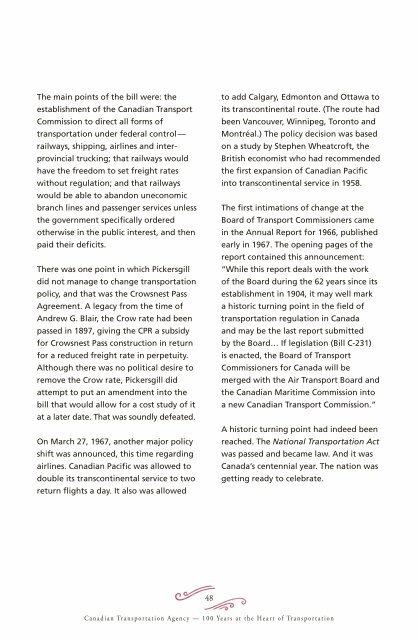The main points of the bill were: theestablishment of the Canadian TransportCommission to direct all forms oftransportation under federal control—railways, shipping, airlines and interprovincialtrucking; that railways wouldhave the freedom to set freight rateswithout regulation; and that railwayswould be able to abandon uneconomicbranch lines and passenger services unlessthe government specifically orderedotherwise in the public interest, and thenpaid their deficits.There was one point in which Pickersgilldid not manage to change transportationpolicy, and that was the Crowsnest PassAgreement. A legacy from the time ofAndrew G. Blair, the Crow rate had beenpassed in 1897, giving the CPR a subsidyfor Crowsnest Pass construction in returnfor a re<strong>du</strong>ced freight rate in perpetuity.Although there was no political <strong>des</strong>ire toremove the Crow rate, Pickersgill didattempt to put an amendment into thebill that would allow for a cost study of itat a later date. That was soundly defeated.On March 27, 1967, another major policyshift was announced, this time regardingairlines. Canadian Pacific was allowed todouble its transcontinental service to tworeturn flights a day. It also was allowedto add Calgary, Edmonton and Ottawa toits transcontinental route. (The route hadbeen Vancouver, Winnipeg, Toronto andMontréal.) The policy decision was basedon a study by Stephen Wheatcroft, theBritish economist who had recommendedthe first expansion of Canadian Pacificinto transcontinental service in 1958.The first intimations of change at theBoard of Transport Commissioners camein the Annual Report for 1966, publishedearly in 1967. The opening pages of thereport contained this announcement:“While this report deals with the workof the Board <strong>du</strong>ring the 62 years since itsestablishment in 1904, it may well marka historic turning point in the field oftransportation regulation in <strong>Canada</strong>and may be the last report submittedby the Board… If legislation (Bill C-231)is enacted, the Board of TransportCommissioners for <strong>Canada</strong> will bemerged with the Air Transport Board andthe Canadian Maritime Commission intoa new Canadian Transport Commission.”A historic turning point had indeed beenreached. The National Transportation Actwas passed and became law. And it was<strong>Canada</strong>’s centennial year. The nation wasgetting ready to celebrate.48Canadian Transportation Agency — 100 Years at the Heart of Transportation
Notes for Chapter TwoThe Board of Transport Commissioners’ annual reports (1938–1966) are the main sourcefor this chapter. The House of Commons Debates were used for relevant discussions ordecisions in Parliament. Canadian newspapers were used as noted in the text.Other sources include:1 Reginald Whitaker, The Government Party,Organizing and Financing the Liberal Partyof <strong>Canada</strong>, 1930–1958, p. 88 and p.180.2 John Robert Columbo, Columbo’s CanadianQuotations, p. 269.3 G.R. Stevens, History of the Canadian NationalRailways, p. 383.4 A.W. Currie, Economics of CanadianTransportation, p. 544.5 Ibid, p. 549.6 Fred Paul Gosse, in his unpublished thesis,The Air Transport Board and Regulation ofCommercial Air Services, for Carleton College,Ottawa, April, 1955, commented that civil servantswere posted to the Air Transport Board.Two chairmen of the Air Transport Board, J.R.Baldwin and W.J. Matthews, were both seniorcivil servants in the Department of Transport.7 A.W. Currie, p. 403.8 Ibid. p. 101–152. Currie gives a good explanationof the series of freight rate cases heardbetween 1946 and 1951.9 Ibid, p. 405.10 Who’s Who in <strong>Canada</strong>, 1957. The Board ofTransport Commissioners Annual Reports alsocarried some biographical information aboutthe Board chairmen.11 Two sources discuss C.D. Howe’s role in theTrans<strong>Canada</strong> PipeLine debate: C.D. Howe:A Biography by Robert Bothwell and WilliamKillbourn, and Seeing <strong>Canada</strong> Whole, AMemoir, by J.W. Pickersgill.12 Peter Pigott, National Treasure, The History ofthe Trans-<strong>Canada</strong> Air Lines, p. 382–385.13 Ibid, p. 387.14 Ibid, p. 382.15 Board of Transport Commissioners, AnnualReport, 1959.16 John Saywell, editor, Canadian AnnualReview, 1962, p. 209.17 John Robert Columbo. Columbo’s CanadianQuotations, p. 475.Chapter Two cover photo:A TCA <strong>Canada</strong>ir DC-4M North Star flying over Kinley Airport, Bermuda, 1950CSTM/CN00026149Chapter Two — ENGINES OF C HANGE 1938 TO 1967
- Page 1 and 2:
A Centennial Historical Perspective
- Page 3: AcknowledgmentsAcentury ago, on Feb
- Page 7 and 8: Chairman’s MessageIn 2004, the Ca
- Page 9: Dealing with Persons with Disabilit
- Page 12 and 13: The Board of Railway Commissioners1
- Page 14 and 15: water transportation and with Ameri
- Page 16 and 17: Laurier would not be deflected from
- Page 18 and 19: declared. Among Laurier’s promise
- Page 20 and 21: that illustrate the early acceptanc
- Page 26 and 27: ailway with other railways that the
- Page 28 and 29: time the Canadian economy entered a
- Page 30 and 31: The next year, the fire inspector r
- Page 32 and 33: Then he set about reforming Canada
- Page 35 and 36: CHAPTER TWOEngines of ChangeThe Boa
- Page 37 and 38: Howe was 49 years old in 1935 whenh
- Page 39 and 40: As the Board reiterated in later wa
- Page 41 and 42: Mackenzie King had made an earlierA
- Page 43 and 44: Wage and price controls were droppe
- Page 45 and 46: this extended period (of freight ra
- Page 47 and 48: development. The Board’s AnnualRe
- Page 49 and 50: moved into the Chief Commissioner
- Page 51 and 52: platform). The Board’s policy app
- Page 53: Prize. On November 8, 1965, the thi
- Page 58 and 59: The Canadian Transport Commission19
- Page 60 and 61: 1967. In late 1968, the CTC set up
- Page 62 and 63: for the different modal committees.
- Page 64 and 65: The railways had also started to in
- Page 66 and 67: The CTC’s policy in this regard i
- Page 68 and 69: CSTM/CN000559things, I want to be a
- Page 70 and 71: government was willing to provide u
- Page 72 and 73: “The reforms that can already be
- Page 74 and 75: Minister Axworthy introduced a newC
- Page 76 and 77: create an agency to replace the Can
- Page 79 and 80: CHAPTER FOURShifting GearsThe Natio
- Page 81 and 82: for a maximum of nine full-time Mem
- Page 83 and 84: compensatory to cover the actual co
- Page 85 and 86: the newspaper report, CNR and CPRwe
- Page 87 and 88: more quickly. The committee alsorec
- Page 89 and 90: Review also noted an increase inint
- Page 91: Notes for Chapter FourThis chapter
- Page 94 and 95: The Canadian Transportation Agency1
- Page 96 and 97: to make transportation accessible t
- Page 98 and 99: would be responsible for investigat
- Page 100 and 101: The Commissioner was required to ma
- Page 102 and 103: In another obesity case, also invol
- Page 104 and 105:
Washington and a field in ruralPenn
- Page 106 and 107:
AppendixMembers’ ListBOARD OF RAI
- Page 108 and 109:
CANADIAN MARITIME COMMISSIONNAME PO
- Page 110 and 111:
B. Keith Penner Member January 1, 1
- Page 112:
Books and ArticlesBercuson, David J





